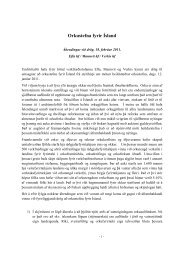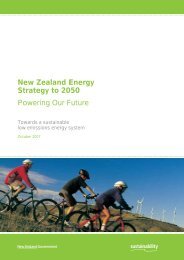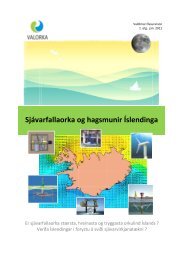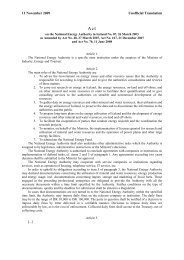a Pioneer in the Use of Renewable Resources - National Energy ...
a Pioneer in the Use of Renewable Resources - National Energy ...
a Pioneer in the Use of Renewable Resources - National Energy ...
You also want an ePaper? Increase the reach of your titles
YUMPU automatically turns print PDFs into web optimized ePapers that Google loves.
Meet<br />
Iceland<br />
– a <strong>Pioneer</strong> <strong>in</strong> <strong>the</strong> <strong>Use</strong> <strong>of</strong> <strong>Renewable</strong> <strong>Resources</strong><br />
The solution to <strong>the</strong> threat <strong>of</strong> climate change is based<br />
on diverse clean, renewable and environmentally sound<br />
sources <strong>of</strong> energy.<br />
Why is Iceland one <strong>of</strong> <strong>the</strong><br />
world’s greatest potential<br />
sources <strong>of</strong> renewable energy<br />
Located just south <strong>of</strong> <strong>the</strong> Arctic Circle,<br />
Iceland is located on both a hotspot<br />
and <strong>the</strong> Mid Atlantic Ridge, which runs<br />
right through it.<br />
This comb<strong>in</strong>ed location means that<br />
geologically <strong>the</strong> island is extremely<br />
active with an eruption every five years<br />
on average.<br />
Despite its fiery nature, about onetenth<br />
<strong>of</strong> Iceland’s landmass is covered<br />
by glaciers, from whose icecaps flow<br />
many powerful rivers, provid<strong>in</strong>g <strong>the</strong><br />
nation with a wealth <strong>of</strong> hydro-power.<br />
The country’s geographical peculiarities<br />
have endowed Iceland with an<br />
abundant supply <strong>of</strong> geo<strong>the</strong>rmal<br />
resources and hydropower.<br />
Iceland has succeeded <strong>in</strong> do<strong>in</strong>g<br />
what many consider impossible:<br />
transform<strong>in</strong>g its energy system from<br />
fossil fuels to clean energy. The use<br />
<strong>of</strong> geo<strong>the</strong>rmal energy <strong>in</strong> Iceland is<br />
highly cost-effective, reliable, clean,<br />
and socially important. It has also<br />
dramatically <strong>in</strong>creased <strong>the</strong> quality <strong>of</strong><br />
life for <strong>the</strong> <strong>in</strong>habitants.<br />
Published <strong>in</strong> September 2009<br />
<strong>National</strong> <strong>Energy</strong> Authority<br />
Provid<strong>in</strong>g Solutions to <strong>the</strong> World<br />
<strong>Renewable</strong> <strong>Energy</strong> <strong>in</strong> Iceland
Harness<strong>in</strong>g<br />
Natural <strong>Resources</strong><br />
Iceland is a country <strong>of</strong> 300,000<br />
people, located on <strong>the</strong> mid-Atlantic<br />
ridge. It is mounta<strong>in</strong>ous and volcanic<br />
with much precipitation. The country’s<br />
geographical peculiarities have<br />
endowed Iceland with an abundant<br />
supply <strong>of</strong> geo<strong>the</strong>rmal resources and<br />
hydropower.<br />
Dur<strong>in</strong>g <strong>the</strong> course <strong>of</strong> <strong>the</strong> 20th century,<br />
Iceland went from what was one <strong>of</strong> Europe’s<br />
poorest countries, dependent upon peat<br />
and imported coal for its energy, to a<br />
country with a high standard <strong>of</strong> liv<strong>in</strong>g where<br />
practically all stationary energy, and <strong>in</strong><br />
2008 roughly 82% <strong>of</strong> primary energy was<br />
derived from <strong>in</strong>digenous renewable sources<br />
(62% geo<strong>the</strong>rmal, 20% hydropower). The<br />
rest <strong>of</strong> Iceland’s energy sources come from<br />
imported fossil fuel used for fish<strong>in</strong>g and<br />
transportation.<br />
Today, this makes Iceland a world leader <strong>in</strong><br />
terms <strong>of</strong> <strong>the</strong> share <strong>of</strong> renewable resources<br />
that <strong>the</strong> country uses.<br />
Iceland’s energy use per capita is among <strong>the</strong><br />
highest <strong>in</strong> <strong>the</strong> world, and <strong>the</strong> proportion <strong>of</strong><br />
this provided by renewable energy sources<br />
exceeds most o<strong>the</strong>r countries. Nowhere else<br />
does geo<strong>the</strong>rmal energy play a greater role<br />
<strong>in</strong> prov<strong>in</strong>g a nation’s energy supply. Almost<br />
three-quarters <strong>of</strong> <strong>the</strong> population live <strong>in</strong> <strong>the</strong><br />
south-western part <strong>of</strong> <strong>the</strong> country, where<br />
geo<strong>the</strong>rmal resources are abundant.<br />
Primary energy consumption <strong>in</strong> Iceland 1940–2008<br />
250<br />
200<br />
150<br />
100<br />
50<br />
250<br />
200<br />
150<br />
Coal<br />
Relative consumption<br />
Oil<br />
100<br />
Geo<strong>the</strong>rmal<br />
50 Peat<br />
Hydropower<br />
0 1945 1965 1985 2005<br />
Coal<br />
Oil<br />
Geo<strong>the</strong>rmal<br />
0<br />
1940<br />
1945<br />
1950<br />
1955<br />
1960<br />
1965<br />
1970<br />
1975<br />
1980<br />
1985<br />
1990<br />
Hydropower<br />
2005<br />
2000<br />
1995<br />
<strong>Renewable</strong> <strong>Energy</strong> <strong>in</strong> Iceland<br />
Provid<strong>in</strong>g Solutions to <strong>the</strong> World
Harness<strong>in</strong>g<br />
Rivers<br />
Less than 10 years after Thomas Edison<br />
opened <strong>the</strong> world’s first hydroelectric<br />
power station, a group <strong>of</strong><br />
visionary Icelanders began explor<strong>in</strong>g<br />
<strong>the</strong> possibility <strong>of</strong> harn ess<strong>in</strong>g some <strong>of</strong><br />
<strong>the</strong>ir own country’s rivers and waterfalls<br />
as an energy source to create<br />
light and heat.<br />
In 1904, Iceland’s first hydropower station<br />
brought electricity to some <strong>in</strong>habitants <strong>of</strong><br />
<strong>the</strong> port <strong>of</strong> Hafnarfjörður, and switches<br />
clicked on <strong>in</strong> Reykjavík <strong>in</strong> 1921. The next<br />
decades saw <strong>the</strong> electrification <strong>of</strong> rural<br />
areas, and 1946 saw <strong>the</strong> formation <strong>of</strong><br />
Iceland State Electricity, followed <strong>in</strong> 1965 by<br />
<strong>the</strong> <strong>National</strong> Power Company (Landsvirkjun).<br />
Demand for electricity <strong>in</strong> Iceland <strong>in</strong>creased<br />
dramatically with <strong>the</strong> open<strong>in</strong>g <strong>of</strong> <strong>the</strong> country’s<br />
first alum<strong>in</strong>ium smelter <strong>in</strong> 1969. Today<br />
80% <strong>of</strong> <strong>the</strong> nation’s electricity use, is due to<br />
power <strong>in</strong>tensive <strong>in</strong>dustries.<br />
At <strong>the</strong> end <strong>of</strong> <strong>the</strong> year 2008, Iceland has<br />
hydroelectric power stations with a total<br />
<strong>in</strong>stalled capacity <strong>of</strong> 1.880 MW.<br />
Provid<strong>in</strong>g Solutions to <strong>the</strong> World<br />
<strong>Renewable</strong> <strong>Energy</strong> <strong>in</strong> Iceland
Nature’s<br />
Central Heat<strong>in</strong>g<br />
Geo<strong>the</strong>rmal energy beg<strong>in</strong>s life as ra<strong>in</strong>water,<br />
which gradually seeps deep<br />
<strong>in</strong>to <strong>the</strong> ground where it is heated<br />
by hot rock. While some <strong>of</strong> this<br />
water returns to <strong>the</strong> surface as hot<br />
spr<strong>in</strong>gs or geysers, most rema<strong>in</strong>s<br />
trapped under ground, from where it is<br />
ex tracted us<strong>in</strong>g technology similar to<br />
that used to obta<strong>in</strong> oil or fresh water.<br />
In <strong>the</strong> active volcanic zone <strong>of</strong> Iceland, 30<br />
high temperature fields have been identified<br />
and on <strong>the</strong> flanks <strong>of</strong> <strong>the</strong> volcanic zone<br />
clusters <strong>of</strong> low temperature fields exist. In<br />
low temper ature systems, temperature <strong>in</strong><br />
<strong>the</strong> uppermost 1000 m may reach up to<br />
150°C. The water is mostly used directly<br />
to supply hot water for district heat<strong>in</strong>g,<br />
green houses, swimm<strong>in</strong>g pools etc. In <strong>the</strong><br />
high temperature fields, on <strong>the</strong> o<strong>the</strong>r hand,<br />
temperatures reach over 200°C at 1000<br />
m depth. Electricity can be generated from<br />
<strong>the</strong>se fields due to <strong>the</strong> high tempera tures<br />
but s<strong>in</strong>ce <strong>the</strong> water is much richer <strong>in</strong> m<strong>in</strong>erals<br />
and gases, <strong>the</strong> hot water is used<br />
for heat<strong>in</strong>g fresh water.<br />
While <strong>the</strong> first attempts at<br />
drill<strong>in</strong>g for hot water <strong>in</strong><br />
Iceland were made <strong>in</strong><br />
<strong>the</strong> mid-18th century,<br />
it was not until 1930<br />
that a Reykjavík<br />
school became <strong>the</strong> city’s first build<strong>in</strong>g to<br />
be heated us<strong>in</strong>g geo<strong>the</strong>rmal water. As<br />
fur<strong>the</strong>r wells followed, more build<strong>in</strong>gs were<br />
connected to <strong>the</strong> system, a process greatly<br />
accelerated by <strong>the</strong> global oil crises <strong>of</strong> <strong>the</strong><br />
early 1970s. Today, almost 90% <strong>of</strong> Iceland’s<br />
houses and build<strong>in</strong>gs are heated by natural<br />
hot water. Geo<strong>the</strong>rmal power facilities currently<br />
generate 25% <strong>of</strong> <strong>the</strong> electricity (4.038<br />
GWh <strong>of</strong> total 16.467 GWh), and <strong>the</strong> <strong>of</strong>ficial<br />
energy forecast projects a 50% <strong>in</strong>crease <strong>in</strong><br />
<strong>the</strong> use <strong>of</strong> geo<strong>the</strong>rmal energy by 2030.<br />
Geo<strong>the</strong>rmal fields<br />
High temperature field<br />
Low temperature field<br />
Bedrock<br />
< 0.8 m. years<br />
0.8 - 3.3 m. years<br />
3.3 - 15 m. years<br />
<strong>Renewable</strong> <strong>Energy</strong> <strong>in</strong> Iceland<br />
Provid<strong>in</strong>g Solutions to <strong>the</strong> World
2008<br />
-91 m<br />
-280 m<br />
2009<br />
-800 m<br />
-2.4 km<br />
Deep resources<br />
– More <strong>Energy</strong><br />
-3.5 km<br />
-4.5 km<br />
The Iceland Deep Drill<strong>in</strong>g Project<br />
(IDDP) is a long-term study <strong>of</strong> hightemperature<br />
hydro<strong>the</strong>rmal systems <strong>in</strong><br />
Iceland.<br />
The IDDP is a collaborative effort by a consortium<br />
<strong>of</strong> Icelandic and foreign power companies<br />
and <strong>the</strong> Icelandic government, formed<br />
to determ<strong>in</strong>e if utiliz<strong>in</strong>g super critical geo<strong>the</strong>rmal<br />
fluids would improve <strong>the</strong> economics <strong>of</strong><br />
power pro ductions from geo<strong>the</strong>rmal fields.<br />
Over <strong>the</strong> next several years <strong>the</strong> IDDP, expects<br />
to drill and test a series <strong>of</strong> boreholes that<br />
will penetrate supercritical zones believed to<br />
be present beneath three currently exploited<br />
geo<strong>the</strong>rmal fields <strong>in</strong> Iceland. This will require<br />
drill<strong>in</strong>g to a depth <strong>of</strong> about 5 km <strong>in</strong> order to<br />
reach hydro<strong>the</strong>rmal fluids at temperatures<br />
rang<strong>in</strong>g from 450°C to ~600°C.<br />
A feasibility study completed <strong>in</strong> 2003<br />
<strong>in</strong>dicates that relative to <strong>the</strong> output from<br />
conventional geo<strong>the</strong>rmal wells, which are<br />
2.5 km deep, a ten-fold <strong>in</strong>crease <strong>in</strong> power<br />
output per well could result if fluid is produced<br />
from reservoirs hotter than 450°C.<br />
A typical 2.5 km-deep geo<strong>the</strong>rmal well<br />
<strong>in</strong> Iceland yields power equivalent to<br />
approximately 5 MWe. Assum<strong>in</strong>g a similar<br />
volumetric <strong>in</strong>flow rate <strong>of</strong> steam, an IDDP<br />
well tapp<strong>in</strong>g a supercritical reservoir at<br />
temperatures above 450°C and at a pressure<br />
<strong>of</strong> 23-26 MPa may be expected to yield<br />
~50 MWe.<br />
Provid<strong>in</strong>g Solutions to <strong>the</strong> World<br />
<strong>Renewable</strong> <strong>Energy</strong> <strong>in</strong> Iceland
Export <strong>of</strong> know-how<br />
– Iceland as an active <strong>in</strong>ternational partner <strong>in</strong><br />
develop<strong>in</strong>g renewable energy<br />
As global warm<strong>in</strong>g poses a threat to<br />
<strong>the</strong> world, it is now mostly acknowledged<br />
that an <strong>in</strong>creased use <strong>of</strong> renewable<br />
energy could play a key role <strong>in</strong><br />
reduc<strong>in</strong>g this development.<br />
Geo<strong>the</strong>rmal energy can play a significant<br />
role <strong>in</strong> <strong>the</strong> electricity production <strong>of</strong> countries<br />
and regions rich <strong>in</strong> high-temperature fields<br />
which are associated with volcanic activity.<br />
Capacity build<strong>in</strong>g and transfer <strong>of</strong> technology<br />
are key issues <strong>in</strong> <strong>the</strong> susta<strong>in</strong>able development<br />
<strong>of</strong> geo<strong>the</strong>rmal resources.<br />
Icelandic emphasis <strong>in</strong> bi-lateral development<br />
assistance has <strong>the</strong>refore focused on<br />
geo<strong>the</strong>rmal energy and cooperation with<br />
countries who sit on unexploited geo <strong>the</strong>rmal<br />
resources. The objective be<strong>in</strong>g to assist <strong>the</strong>m<br />
to develop <strong>the</strong>ir renewable energy resources.<br />
<strong>the</strong> Phillip<strong>in</strong>es, Germany, Hungary, Djibouti,<br />
Eritrea, Nicaragua, and El Salvador to name<br />
but a few examples.<br />
Eng<strong>in</strong>eer<strong>in</strong>g and consult<strong>in</strong>g companies:<br />
Efla – www.efla.is<br />
Icelandic Geosurvey – www.isor.is<br />
Mannvit – www.mannvit.is<br />
Verkís – www.verkis.is<br />
<strong>Energy</strong> and contract<strong>in</strong>g companies:<br />
Geysir Green <strong>Energy</strong> – www.gge.is<br />
Iceland Drill<strong>in</strong>g – www.iceland-drill<strong>in</strong>g.com<br />
Icelandic State Electricity – www.rarik.is<br />
HS Orka – www.hsorka.is<br />
Landsvirkjun Power – www.lvp.is<br />
Reykjavik <strong>Energy</strong> – www.or.is<br />
In addition, several Icelandic companies<br />
make it <strong>the</strong>ir bus<strong>in</strong>ess to export geo <strong>the</strong>rmal<br />
and hydropower know-how and experi ence.<br />
Icelandic experts participate <strong>in</strong> geo<strong>the</strong>rmal<br />
projects worldwide, and have contributed to<br />
<strong>the</strong> world’s best known geo<strong>the</strong>rmal projects.<br />
Geo<strong>the</strong>rmal experts from Iceland are now at<br />
work <strong>in</strong> <strong>the</strong> United States, Ch<strong>in</strong>a, Indonesia,<br />
Geo<strong>the</strong>rmal projects with<br />
Icelandic participation.<br />
Hot temperature zones where<br />
geo<strong>the</strong>rmal power can best be<br />
harnessed. New technology<br />
can open up more areas.<br />
<strong>Renewable</strong> <strong>Energy</strong> <strong>in</strong> Iceland<br />
Provid<strong>in</strong>g Solutions to <strong>the</strong> World
Knowledge<br />
is Power<br />
<strong>Renewable</strong> energy has become an<br />
important field <strong>of</strong> study <strong>in</strong> Iceland.<br />
The Icelandic universities have taken<br />
<strong>the</strong> lead, found<strong>in</strong>g graduate and<br />
post-graduate courses <strong>in</strong> many fields<br />
<strong>of</strong> exper tise <strong>in</strong> clean energy, collaborat<strong>in</strong>g<br />
with some <strong>of</strong> <strong>the</strong> world’s<br />
lead<strong>in</strong>g <strong>in</strong>stitutions.<br />
UNU-GTP – The United<br />
Nations Geo<strong>the</strong>rmal Tra<strong>in</strong><strong>in</strong>g<br />
Programme<br />
www.unugtp.is<br />
The UNU-GTP has s<strong>in</strong>ce<br />
1979 been assist<strong>in</strong>g<br />
develop<strong>in</strong>g countries with<br />
significant geo<strong>the</strong>rmal<br />
potential to establish<br />
groups <strong>of</strong> specialists <strong>in</strong> geo<strong>the</strong>rmal exploration<br />
and developement by <strong>of</strong>fer<strong>in</strong>g six<br />
month specialised tra<strong>in</strong><strong>in</strong>g and, fur<strong>the</strong>r more,<br />
<strong>the</strong> possibility <strong>of</strong> extend<strong>in</strong>g <strong>the</strong>ir studies to a<br />
MSc and PhD degree <strong>in</strong> geo <strong>the</strong>rmal sciences<br />
or eng<strong>in</strong>eer<strong>in</strong>g, <strong>in</strong> cooperation with <strong>the</strong><br />
University <strong>of</strong> Iceland.<br />
RES – The School for<br />
<strong>Renewable</strong> <strong>Energy</strong> Science<br />
www.res.is<br />
RES has s<strong>in</strong>ce <strong>the</strong> year<br />
2007 <strong>of</strong>fered an <strong>in</strong>tensive<br />
and unique <strong>in</strong>ter discipl<strong>in</strong>ary<br />
research oriented one-year graduate<br />
programme <strong>in</strong> <strong>Renewable</strong> <strong>Energy</strong> Science.<br />
The pro gramme is <strong>of</strong>fered <strong>in</strong> cooperation<br />
with University <strong>of</strong> Iceland and University<br />
<strong>of</strong> Akureyri, as well as <strong>in</strong> partner ship with<br />
a number <strong>of</strong> lead<strong>in</strong>g technical universities<br />
around <strong>the</strong> world. In 2009 <strong>the</strong> school will<br />
<strong>of</strong>fer four specialisations <strong>of</strong> study: Geo<strong>the</strong>rmal<br />
<strong>Energy</strong>; Fuel Cell Systems & Hydrogen;<br />
Bi<strong>of</strong>uels & Bioenergy; and <strong>Energy</strong> Systems<br />
& Policies.<br />
REYST – Reykjavik <strong>Energy</strong><br />
Graduate School <strong>of</strong><br />
Susta<strong>in</strong>able Systems<br />
www.reyst.is<br />
S<strong>in</strong>ce 2008 <strong>the</strong><br />
school has <strong>of</strong>fered<br />
an <strong>in</strong>ternational<br />
graduate programme based on <strong>the</strong> three<br />
pillars <strong>of</strong> eng<strong>in</strong>eer<strong>in</strong>g, earth science and<br />
bus<strong>in</strong>ess. The pro gramme is characterized by<br />
its focus on susta<strong>in</strong>able energy use, practical<br />
experience <strong>in</strong> <strong>the</strong> field and ready access<br />
to on-site work with experts on various<br />
subjects.<br />
The University <strong>of</strong> Iceland<br />
www.hi.is<br />
The University <strong>of</strong> Iceland is an<br />
active coord<strong>in</strong>ative partner <strong>in</strong><br />
<strong>the</strong> programmes <strong>of</strong> REYST, RES<br />
and KEILIR., but also <strong>of</strong>fers <strong>in</strong>-house graduate<br />
studies <strong>in</strong> <strong>the</strong> field <strong>of</strong> <strong>Renewable</strong> <strong>Energy</strong><br />
Eng<strong>in</strong>eer<strong>in</strong>g: an <strong>in</strong>terdischipl<strong>in</strong>ary study on<br />
<strong>the</strong> technical and environmental aspect harness<strong>in</strong>g,<br />
distribut<strong>in</strong>g and consum<strong>in</strong>g energy<br />
<strong>in</strong> a susta<strong>in</strong>able manner.<br />
Reykjavik University<br />
www.ru.is<br />
Reykjavik University <strong>of</strong>fers a BSc programme<br />
<strong>in</strong> Mechanical and <strong>Energy</strong> Eng<strong>in</strong>eer<strong>in</strong>g with<br />
a strong tradition <strong>of</strong> practical orientation <strong>in</strong><br />
cooperation with <strong>the</strong> <strong>in</strong>dustry. The research<br />
focus is on applied research <strong>in</strong> cooperation<br />
with specialized companies and <strong>in</strong>stitutions<br />
<strong>in</strong> <strong>the</strong> energy field.<br />
Provid<strong>in</strong>g Solutions to <strong>the</strong> World<br />
<strong>Renewable</strong> <strong>Energy</strong> <strong>in</strong> Iceland
Alternative Fuels<br />
In spite <strong>of</strong> <strong>the</strong> widespread use <strong>of</strong><br />
renewables for electricity and heat<strong>in</strong>g,<br />
Iceland is still dependent on fossil<br />
fuels when it comes to transportation<br />
and fish<strong>in</strong>g. Those two categories represent<br />
about a third <strong>of</strong> <strong>the</strong> country’s<br />
CO2 emissions.<br />
Distribution <strong>of</strong> CO 2<br />
emissions by source <strong>in</strong> 2006<br />
stationary<br />
combustion oil<br />
5%<br />
road vehicles<br />
28%<br />
<strong>in</strong>dustrial processes<br />
31%<br />
fish<strong>in</strong>g<br />
18%<br />
construction<br />
7%<br />
geo<strong>the</strong>rmal<br />
5%<br />
o<strong>the</strong>r<br />
2%<br />
All fossil fuels are imported, and <strong>the</strong> price<br />
tag is about one tenth <strong>of</strong> <strong>the</strong> cost <strong>of</strong> Iceland’s<br />
entire imports. F<strong>in</strong>d<strong>in</strong>g alternatives<br />
to fossil fuels should <strong>the</strong>refore be a priority,<br />
especially those alternative fuels that can be<br />
produced locally.<br />
Electricity based alternatives, such as battery<br />
vehicles, hydrogen and designer fuels<br />
are obvious candidates for Iceland, given<br />
<strong>the</strong> country’s abundant renewable energy<br />
resources. However, bi<strong>of</strong>uels shouldn’t be<br />
overlooked, <strong>in</strong> particular those that can be<br />
produced by utiliz<strong>in</strong>g waste products.<br />
The Icelandic government supports <strong>in</strong>novative<br />
companies <strong>in</strong> clean energy, energy<br />
efficiency, and clean technology. These are a<br />
couple <strong>of</strong> expamles:<br />
SMART H2 is one <strong>of</strong> many ongo<strong>in</strong>g alternative<br />
fuel projects <strong>in</strong> Iceland, managed by<br />
Icelandic New <strong>Energy</strong>. It’s a demonstration<br />
project test<strong>in</strong>g hydrogen fuelled<br />
vehicles and vessels, <strong>in</strong>clud<strong>in</strong>g a hydrogen<br />
auxiliary power unit for a whale safari tour<br />
ship – shown on picture above.<br />
Carbon Recycl<strong>in</strong>g<br />
International captures<br />
carbon dioxide from<br />
<strong>in</strong>dustrial emissions and<br />
converts carbon dioxide<br />
to ultra clean fuel. The<br />
sources <strong>of</strong> emissions can be from basic<br />
<strong>in</strong>frastructure <strong>in</strong>dustrial processes <strong>in</strong>clud<strong>in</strong>g<br />
geo<strong>the</strong>rmal power plants, alum<strong>in</strong>um smelt<strong>in</strong>g,<br />
ferro silicon manufactur<strong>in</strong>g, cement<br />
production and coal fired power generation.<br />
Carbon Recycl<strong>in</strong>g International was selected<br />
at Cleantech Forum XXII <strong>in</strong> Copenhagen <strong>in</strong><br />
April 2009 as one <strong>of</strong> <strong>the</strong> five most promis<strong>in</strong>g<br />
cleantech firms <strong>in</strong> <strong>the</strong> Nordic region.<br />
Marorka is a lead<strong>in</strong>g producer <strong>of</strong> energy<br />
management systems for ocean vessels.<br />
The company’s aim is to enable customers<br />
to maximize <strong>the</strong>ir operat<strong>in</strong>g results by<br />
m<strong>in</strong>imiz<strong>in</strong>g fuel consumption and harmful<br />
emissions. Marorka won <strong>the</strong> Nature and<br />
Environment Prize awarded by <strong>the</strong> Nordic<br />
Council <strong>in</strong> 2008.<br />
<strong>Renewable</strong> <strong>Energy</strong> <strong>in</strong> Iceland<br />
Provid<strong>in</strong>g Solutions to <strong>the</strong> World
Bi<strong>of</strong>uels<br />
<strong>in</strong> Iceland<br />
Methane<br />
Methane has been collected from a waste<br />
yard s<strong>in</strong>ce 2000 and utilized as fuel for<br />
transport s<strong>in</strong>ce 2003. It is estimated that <strong>the</strong><br />
production capacity <strong>of</strong> <strong>the</strong> methane collect<strong>in</strong>g<br />
yard is enough to provide about 4000<br />
cars with fuel, but so far only a fraction <strong>of</strong><br />
that number are us<strong>in</strong>g methane.<br />
Metan Ltd.<br />
Metan Ltd. was founded as a subsidiary <strong>of</strong><br />
<strong>the</strong> waste disposal company Sorpa, with <strong>the</strong><br />
purpose <strong>of</strong> produc<strong>in</strong>g and sell<strong>in</strong>g energy<br />
from waste landfills. Metan Ltd. is now a<br />
market<strong>in</strong>g and development company for<br />
alternative fuel <strong>in</strong> <strong>the</strong> form <strong>of</strong> methane. The<br />
role <strong>of</strong> <strong>the</strong> company is to market and distribute<br />
energy <strong>in</strong> <strong>the</strong> form <strong>of</strong> electricity, raw gas,<br />
landfill gas and upgraded methane as well<br />
as knowledge collection with<strong>in</strong> <strong>the</strong> field <strong>of</strong><br />
biogas and landfill gas utilization.<br />
Ethanol<br />
Ethanol has been imported s<strong>in</strong>ce 2007<br />
and sold as an E85 fuel blend. Ethanol is<br />
produced us<strong>in</strong>g plant waste, energy crops<br />
or <strong>in</strong>dustrial waste. It is possible to produce<br />
ethanol locally although <strong>the</strong> climate <strong>in</strong><br />
Iceland is not ideal for grow<strong>in</strong>g energy<br />
crops. Ethanol can be blended <strong>in</strong> gasol<strong>in</strong>e as<br />
an additive and as such utilizes <strong>the</strong> current<br />
<strong>in</strong>frastructure.<br />
Biodiesel<br />
Biodiesel has been imported s<strong>in</strong>ce 2004 and<br />
sold as a B5 or B10 fuel blend. Biodiesel can<br />
be blended with fossil diesel oil and as such<br />
utilizes <strong>the</strong> current <strong>in</strong>frastructure. Biodiesel<br />
is produced us<strong>in</strong>g animal waste or energy<br />
crops. It is possible to produce biodiesel<br />
locally from waste fat from food production<br />
or energy crops.<br />
Us<strong>in</strong>g current technology <strong>in</strong> bi<strong>of</strong>uels, it is<br />
difficult or even impossible to substitute <strong>the</strong><br />
entire fossil fuel use <strong>in</strong> Iceland with bi<strong>of</strong>uels<br />
produced locally. However, it is quite possible<br />
to substitute some <strong>of</strong> <strong>the</strong> fossil fuel use<br />
with locally produced bi<strong>of</strong>uels from waste.<br />
Such production reduces waste, CO2 emissions<br />
and lessens Iceland’s dependence on<br />
imported fuels.<br />
Provid<strong>in</strong>g Solutions to <strong>the</strong> World<br />
<strong>Renewable</strong> <strong>Energy</strong> <strong>in</strong> Iceland
Electricity<br />
as a Fuel<br />
The Icelandic President, Olafur Ragnar Grimsson,<br />
test-driv<strong>in</strong>g <strong>the</strong> electric vehicle Mitshubishi i-Miev.<br />
In 2008 Mitshubishi Motors Corporationh and <strong>the</strong><br />
Icelandic M<strong>in</strong>istry <strong>of</strong> INdustry, <strong>Energy</strong>, and Tourism,<br />
signed a MoU regard<strong>in</strong>g fleet test<strong>in</strong>g <strong>of</strong> <strong>the</strong> zero<br />
emissions i-Miev electric car. The fleet test<strong>in</strong>g will<br />
start <strong>in</strong> 2009.<br />
• All electricity <strong>in</strong> Iceland is<br />
produced from renewable<br />
energy sources – 100%<br />
• This means that all use <strong>of</strong><br />
electricity <strong>in</strong> transport, <strong>in</strong><br />
Iceland, can be fossil free from<br />
well to wheel<br />
Fossil Free<br />
Iceland is ideal for utiliz<strong>in</strong>g electricity as<br />
fuel, s<strong>in</strong>ce all electricity is produced from<br />
renewable resources, and is <strong>the</strong>refore mostly<br />
CO2 free. Electricity can be used directly <strong>in</strong><br />
battery vehicles, or as designer fuels, <strong>in</strong>clud<strong>in</strong>g<br />
hydrogen. Cleaner vehicle technologies<br />
help everyone brea<strong>the</strong> easier, cut down<br />
greenhouse gas emissions and reduce our<br />
dependence on imported fossil fuels. Electric<br />
drive is a compell<strong>in</strong>g solution to <strong>the</strong>se<br />
national concerns.<br />
Improv<strong>in</strong>g Efficiency<br />
The efficiency <strong>of</strong> electricity as a fuel is<br />
strongly dependent on <strong>the</strong> medium used.<br />
Battery vehicles have <strong>the</strong> highest efficiency,<br />
but <strong>the</strong> energy density <strong>of</strong> batteries is ra<strong>the</strong>r<br />
small, and it is <strong>the</strong>refore difficult to imag<strong>in</strong>e<br />
battery powered ships or airplanes. Fuel<br />
cells us<strong>in</strong>g hydrogen are somewhat more<br />
efficient, but expensive. Designer fuels are<br />
<strong>the</strong> least efficient, but <strong>of</strong>ten easiest to use<br />
s<strong>in</strong>ce <strong>the</strong>y can utilize exist<strong>in</strong>g <strong>in</strong>frastructure.<br />
Electric Drive <strong>in</strong> Iceland<br />
Chang<strong>in</strong>g <strong>the</strong> fleet to electric drive won’t<br />
happen overnight. It will require sub stantial<br />
<strong>in</strong>vestments <strong>in</strong> technology, manufactur<strong>in</strong>g,<br />
moderniz<strong>in</strong>g <strong>in</strong>frastructure and market<br />
development. This is why we need to get on<br />
<strong>the</strong> right road, right away and why Iceland<br />
already has several experimental projects <strong>in</strong><br />
various stages concern<strong>in</strong>g <strong>the</strong> utilization <strong>of</strong><br />
electricity as fuel. To name a few examples:<br />
• A project concern<strong>in</strong>g <strong>the</strong> conversion <strong>of</strong> a<br />
hybrid car <strong>in</strong>to a plug-<strong>in</strong> hybrid.<br />
• Fleet vehicle test<strong>in</strong>g <strong>of</strong> electric vehicles<br />
with lithium batteries.<br />
• Feasibility studies <strong>of</strong> designer fuels<br />
production and pilot plants.<br />
• A very successful and a long runn<strong>in</strong>g<br />
hydrogen project has seen <strong>the</strong> operation<br />
<strong>of</strong> hydrogen busses, passenger cars and<br />
even <strong>the</strong> <strong>in</strong>stallation <strong>of</strong> a hydrogen fuel<br />
cell as an auxilliary eng<strong>in</strong>e on board a<br />
whale watch<strong>in</strong>g ship.<br />
<strong>Renewable</strong> <strong>Energy</strong> <strong>in</strong> Iceland<br />
Provid<strong>in</strong>g Solutions to <strong>the</strong> World
<strong>Energy</strong> Meets<br />
Tourism<br />
The Icelandic energy <strong>in</strong>dustry has<br />
opened up it’s doors to all those <strong>in</strong>terested<br />
<strong>in</strong> <strong>the</strong> development <strong>of</strong> renewable<br />
energy <strong>in</strong> Iceland, it’s products,<br />
and by-products.<br />
Power Plants<br />
In Iceland, various high tech geo <strong>the</strong>rmal<br />
power plants, as well as hydropower plants,<br />
have an open door policy and <strong>of</strong>fer tours<br />
around <strong>the</strong>ir facilities, explan<strong>in</strong>g <strong>the</strong> technical<br />
aspects <strong>of</strong> how <strong>the</strong>y generate power.<br />
Power Plant Earth<br />
Power Plant Earth is a new exhibition located<br />
<strong>in</strong> Reykjanesvirkjun, a geo<strong>the</strong>rmal power<br />
plant. Located <strong>in</strong> a lava field <strong>in</strong> <strong>the</strong> south<br />
west po<strong>in</strong>t <strong>of</strong> <strong>the</strong> Reykjanes pen<strong>in</strong>sula it´s<br />
natural surround<strong>in</strong>gs make it an extraord<strong>in</strong>ary<br />
place to visit. The museum is only a 15<br />
m<strong>in</strong>. drive away from <strong>the</strong> Blue Lagoon.<br />
Mývatn Nature Baths<br />
Conta<strong>in</strong><strong>in</strong>g a unique blend <strong>of</strong> m<strong>in</strong>erals,<br />
silicates and geo<strong>the</strong>rmal microorganisms,<br />
<strong>the</strong> warm, sooth<strong>in</strong>g waters <strong>of</strong> Mývatn<br />
Nature Baths are beneficial to sk<strong>in</strong> and<br />
spirit alike, creat<strong>in</strong>g a sense <strong>of</strong> wellbe<strong>in</strong>g<br />
which l<strong>in</strong>gers on as a last<strong>in</strong>g memory<br />
<strong>of</strong> your visit to this spellb<strong>in</strong>d<strong>in</strong>g area at<br />
Europe´s outer limits.<br />
Blue Lagoon<br />
The Blue Lagoon geo<strong>the</strong>rmal spa <strong>of</strong>fer<strong>in</strong>g<br />
a unique experience based on bath<strong>in</strong>g <strong>in</strong><br />
<strong>the</strong> Blue Lagoon geo<strong>the</strong>rmal br<strong>in</strong>e, a<br />
unique ecocycle where high technology<br />
and nature work <strong>in</strong> perfect harmony <strong>in</strong><br />
Iceland’s extreme environment.<br />
Nauthólsvík<br />
Geo<strong>the</strong>rmal Beach<br />
In Iceland <strong>the</strong> sea is normally far too cold<br />
to tempt swimmers, but at Nautholsvik bay<br />
<strong>in</strong> Reykjavik, a <strong>the</strong>rmal beach has been<br />
created, where natural hot water flows out<br />
<strong>in</strong>to <strong>the</strong> sea, and you can frolic <strong>in</strong> <strong>the</strong><br />
waves as if you were <strong>in</strong> <strong>the</strong> Mediterranean!<br />
Thermal Pools<br />
Heat<strong>in</strong>g <strong>of</strong> outdoor swimm<strong>in</strong>g pools is<br />
among <strong>the</strong> most important uses <strong>of</strong> geo<strong>the</strong>rrmal<br />
energy <strong>in</strong> Iceland. There are 136<br />
recreational swimm<strong>in</strong>g centers <strong>in</strong> Iceland<br />
us<strong>in</strong>g geo<strong>the</strong>rmal heat. One <strong>of</strong> <strong>the</strong> delights<br />
<strong>of</strong> a visit to Iceland is bath<strong>in</strong>g <strong>in</strong> one <strong>of</strong> <strong>the</strong><br />
many <strong>the</strong>rmal pools, filled with geo <strong>the</strong>rmally<br />
heated water. The pools are mostly open-air,<br />
and always pleasantly warm - whatever<br />
<strong>the</strong> wea<strong>the</strong>r - and most have outdoor<br />
whirlpools or ‘hot-pots’ to bask <strong>in</strong> before or<br />
after swimm<strong>in</strong>g.<br />
Provid<strong>in</strong>g Solutions to <strong>the</strong> World<br />
<strong>Renewable</strong> <strong>Energy</strong> <strong>in</strong> Iceland
<strong>National</strong> <strong>Energy</strong> Authority<br />
<strong>National</strong> <strong>Energy</strong> Authority<br />
Grensasvegur 9<br />
IS-108 Reykjavik<br />
Iceland<br />
Tel: +354 569 6000<br />
Fax: +354 568 8896<br />
www.nea.is<br />
S KAPARINN AUGLÝSINGASTOF A<br />
<strong>Renewable</strong> <strong>Energy</strong> <strong>in</strong> Iceland<br />
Provid<strong>in</strong>g Solutions to <strong>the</strong> World











